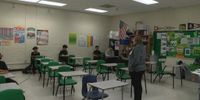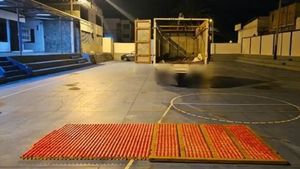Across the United States, school districts are turning to local voters for support as they seek to address aging infrastructure, improve learning environments, and keep up with the demands of modern education. In recent weeks, communities from Arizona to Michigan and New York have debated and, in some cases, approved substantial bond measures dedicated to repairing, upgrading, and expanding their public schools. These initiatives, while differing in size and scope, share a common thread: a pressing need for investment in the very basics of education—safe buildings, functioning bathrooms, reliable electrical systems, and up-to-date technology.
In Tucson, Arizona, the Sunnyside Unified School District is at the center of such a campaign. According to 13 News, Sunnyside is asking taxpayers to support Proposition 416, a $120 million bond aimed squarely at fixing flooded bathrooms, broken electrical outlets, and falling ceiling tiles—problems that have become all too familiar for students and staff. For homeowners, the cost would be about $3.67 per month for every $100,000 in home value, a fee district officials argue is a small price to pay for essential repairs.
Rachael Eggebeen, Vice President of the Sunnyside Educators Association and an eighth-grade social studies teacher at Apollo Middle, described the dire state of facilities. Flooded bathrooms are so frequent, she said, that students sometimes trek across campus just to find a working restroom. “Instead of a four-minute bathroom trip, we now have a 20-minute trip – you have to find a bathroom across the campus,” Eggebeen told 13 News. This isn’t just an inconvenience; it’s a disruption to learning, as students like Francisco Macias can attest. “When I walk into the room, they’re on a whole other subject, and my previous notes and work – I can’t finish it,” Macias explained.
But the issues go beyond plumbing. Eggebeen pointed out deteriorating electrical conduits and malfunctioning outlets, which make it difficult for students to charge laptops and engage with digital lessons. The bond proposal would direct about $60 million toward Sunnyside High, where renovations would include repairing peeling paint, fixing non-functional lockers, replacing falling ceiling tiles, and installing accessible door systems for wheelchair users.
Eggebeen was clear that the district isn’t seeking extravagance. “We’re not asking them to build a giant football stadium, we’re asking voters to pay for basics,” she said. The lack of sufficient state and federal funding has left local taxpayers to shoulder the burden, a situation she finds frustrating given Arizona’s constitutional requirement for the legislature to fund education, including school maintenance. “Every school needs critical infrastructure investments because we haven’t had the money from the state and the federal government to do basic things,” Eggebeen added.
Ballots for Proposition 416 have already been mailed out, with the voting window closing on November 4. Fact sheets in both English and Spanish are available for residents seeking more information. Sunnyside isn’t alone in this push; similar measures are on the ballot in Tucson Unified and Flowing Wells school districts, as reported by 13 News.
Meanwhile, in Oregon, the West Linn-Wilsonville School District is asking voters to approve a $190 million bond this November, according to local reporting. The funds would go toward building maintenance, repairs, upgrades, curriculum, and technology improvements. Notably, the bond would keep the district’s property tax rate steady at $1.06 per $1,000 of assessed value. For a homeowner with a property valued at $400,000, that translates to an estimated $424 per year if the bond passes. The district has made clear that the measure is not about increasing taxes but about maintaining and improving facilities and resources without additional financial strain on homeowners.
In Michigan, the future of Coldwater High School is under discussion, with Superintendent Paul Flynn presenting options to a community committee for consideration. As reported on October 14, Flynn outlined the committee’s recommendation: a $64 million bond to fund a 62,000-square-foot, two-story addition on the northwest corner of the existing building, along with broader renovations. The proposal, shaped in consultation with TMP Architecture, could go before voters in May 2026 if the school board gives its approval by January. The goal is to ensure that Coldwater’s facilities can meet the needs of students for decades to come, reflecting a community-driven approach to long-term planning.
While some districts are still in the proposal phase, others have already seen their bond measures approved. In Norwood, New York, the Norwood-Norfolk Central School District received overwhelming support for its $21.3 million project, which voters backed by a margin of 130 to 29, according to WWNY. The project will address critical repairs, replace outdated equipment and infrastructure, and modernize athletic spaces. Funding will come from $3 million in district reserves and $18 million through bonding, with the state reimbursing 98 percent of the cost—a factor that means the project is not expected to raise local taxes. Superintendent Brooke Ashley celebrated the result, stating, “This vote is an incredible representation of Flyer Pride and affirms our shared commitment to providing a safe, welcoming and inspiring space for working, learning, and growing.” District officials anticipate that the work will be completed by late 2028.
These stories, while rooted in different communities with distinct needs, all point to a broader trend: the growing reliance on local bonds as a means to fund school infrastructure. The reasons are varied but often come down to state and federal funding shortfalls, aging buildings, and a recognition that quality education depends on more than just teachers and textbooks—it requires safe, functional spaces where students can learn without distraction.
For many communities, the choice is not about whether to invest but how to do so responsibly and equitably. The bond measures often spark debate over tax burdens, priorities, and the role of government, but the underlying message is clear: without action, the problems only get worse. As Eggebeen in Tucson put it, fixing old pipes and addressing basic maintenance isn’t just about comfort—it’s about giving students a fair shot at success.
As ballots are cast and communities weigh their options, the outcomes of these votes will shape the educational landscape for years to come. Whether through new additions, repaired bathrooms, or upgraded technology, the investments made today will echo in the classrooms—and futures—of tomorrow’s students.





